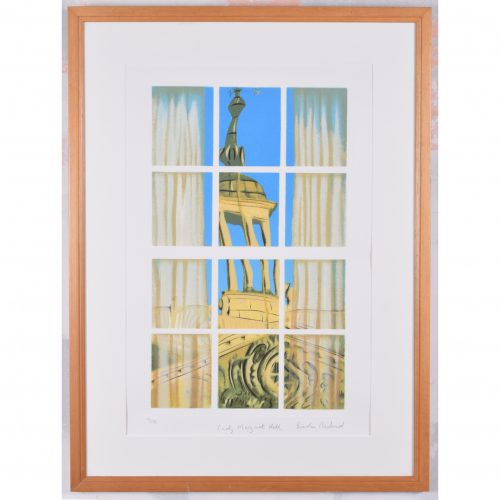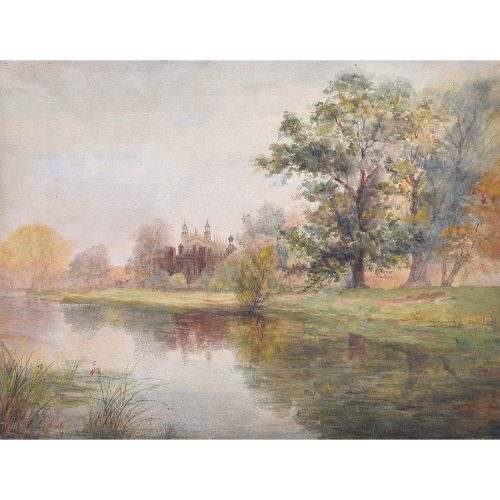-
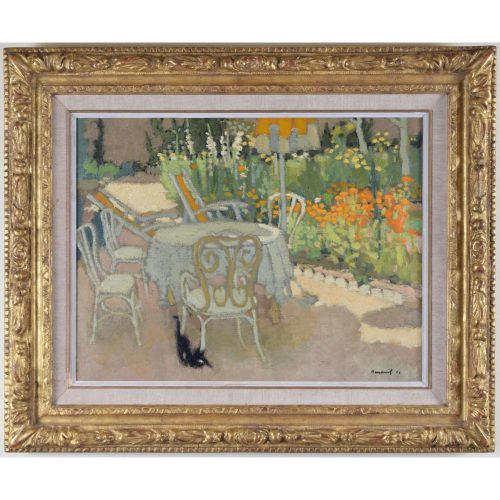
Michel Dureil (1929 - 2011)
La Table du Jardin / Garden Table with a Black Cat
Oil on canvas 35 x 44 cm A black cat stretches beside a typical French table, observed by bright orange flowers. Orange cushions and an orange sun-umbrella complete the scene. Condition: very good. If you are interested, please email info@manningfineart.co.uk or call us on 07929 749056. -

Attributed to Joseph Nash (1808-1878) 'Ruins of an Italian Villa'
Watercolour 24 x 29cm If you are interested email info@manningfineart.co.uk or call us on 07929 749056. Condition: Excellent. -
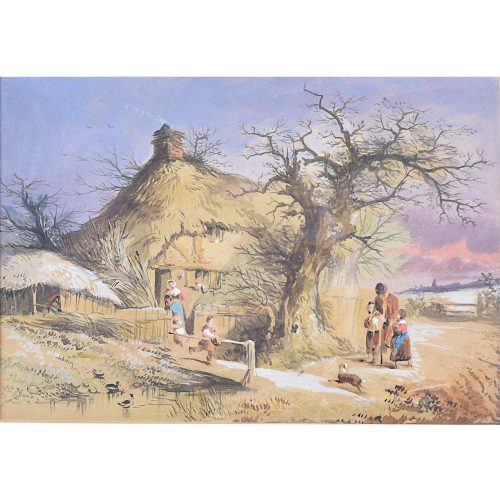
Attributed to Joseph Murray Ince (1806-1859) Outside Welsh Border Cottage - Winter
Watercolour 10.5x17.5cm Brought up in Radnorshire, in the Welsh Borders, Ince studied under David Cox from 1823-1826, and then exhibited at the Royal Academy. He was a drawing master at Cambridge University during the 1830s, during which period he painted many views of the Colleges of both Oxford and Cambridge, returning to Radnorshire in 1835. His works are in the collections of major galleries including the Tate, The V&A and The Fitzwilliam Museum in Cambridge. Click to view other works by Ince. -

Joseph Murray Ince (1806-1859) Outside Welsh Border Cottage - Summer
Watercolour 10.5x17.5cm Provenance (label to reverse) Fine Art Society 1971 Signed lower right 'J M Ince 1827' Brought up in Radnorshire, in the Welsh Borders, Ince studied under David Cox from 1823-1826, and then exhibited at the Royal Academy. He was a drawing master at Cambridge University during the 1830s, during which period he painted many views of the Colleges of both Oxford and Cambridge, returning to Radnorshire in 1835. His works are in the collections of major galleries including the Tate, The V&A and The Fitzwilliam Museum in Cambridge. -

John Speed/Speede (1551/2-1629) The Countye Palatine of Chester with that most ancient citie
39x51cm Engraving Probably the most famous early English mapmaker, John Speed's early life is somewhat of an enigma. He is believed to have trained as a rolling-press printer, but he was at heart an historian granted a sinecure in the Customs House by Queen Elizabeth to indulge his passion, later becoming a Fellow of the Society of Antiquaries. His first maps were historical, of the Holy Land 'Canaan as it was Possessed both in Abraham and Israels Dayes' and of England and Ireland recording 'all their Civill Warres since the Conquest'. In 1611 he published his 'Hostory of Great Britaine' which he regarded as his magnum opus, but it was the companion atlas 'Theatre of the Empire of Great Britaine' that - as the first printed atlas of Great Britain - sealed his reputation. William Rogers engraved the first map, 'the County Palatine of Chester' in about 1600, but following his untimely death the task of engraving was passed to Jodocus Hondius of Amsterdam. By 1612 the atlas was complete, the maps famed for their decorative elements. Many have town plans - Brtiain's first series of such plans - and descriptive text was printed to the reverse until the 1676 edition. Later printings (up until 1770) were issued without this text. By 1627 it has become a part of a world atlas 'Prospect of the Most Famous Parts of the World'. During the 17th century the plates passed through the hands of a series of publishers, the 1676 edition (as here) of Thomas Bassett and Richard Chiswell being regarded as its high point with the inclusion for the first time of a series of important maps. If you are interested email info@manningfineart.co.uk or call us on 07929 749056. Condition: Trimmed and other small losses outside platemark. Some toning and spotting to paper as usual. Later but well undertaken hand-colouring. Old tape mark to top outside platemark. Generally good condition. -
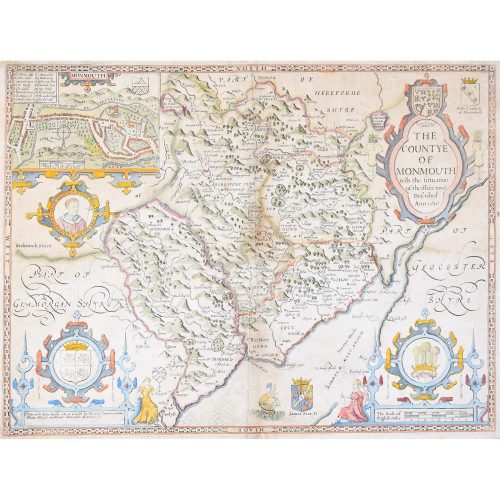
John Speed/Speede (1551/2-1629) The Countye of Monmouthshire
Performed by John Speede assisted by William Smyth. And are to be sold by Henry Overton at the White Horse without Newgate London. Printed 1710-1743 Probably the most famous early English mapmaker, John Speed's early life is somewhat of an enigma. He is believed to have trained as a rolling-press printer, but he was at heart an historian granted a sinecure in the Customs House by Queen Elizabeth to indulge his passion, later becoming a Fellow of the Society of Antiquaries. His first maps were historical, of the Holy Land 'Canaan as it was Possessed both in Abraham and Israels Dayes' and of England and Ireland recording 'all their Civill Warres since the Conquest'. In 1611 he published his 'Hostory of Great Britaine' which he regarded as his magnum opus, but it was the companion atlas 'Theatre of the Empire of Great Britaine' that - as the first printed atlas of Great Britain - sealed his reputation. William Rogers engraved the first map, 'the County Palatine of Chester' in about 1600, but following his untimely death the task of engraving was passed to Jodocus Hondius of Amsterdam. By 1612 the atlas was complete, the maps famed for their decorative elements. Many have town plans - Britain's first series of such plans - and descriptive text was printed to the reverse until the 1676 edition. Later printings (up until 1770) were issued without this text. By 1627 it has become a part of a world atlas 'Prospect of the Most Famous Parts of the World'. During the 17th century the plates passed through the hands of a series of publishers, the 1676 edition of Thomas Bassett and Richard Chiswell being regarded as its high point with the inclusion for the first time of a series of important maps. For the first half of the eighteenth century they were firmly established in the hands of the Overton family. If you are interested email info@manningfineart.co.uk or call us on 07929 749056. Condition: Small losses outside platemark just reaching platemark at top, with some toning to paper as usual. Later but well undertaken hand-colouring. Generally good condition. -
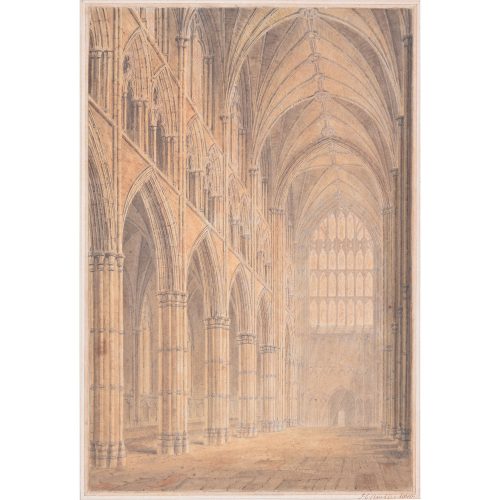
John Chessel Buckler (1793-1894)
The Nave of Westminster Abbey
Watercolour Signed, Titled and dated 1810 25x17 cm Click here for other works by Buckler and biographical detail. If you are interested email info@manningfineart.co.uk or call us on 07929 749056. -
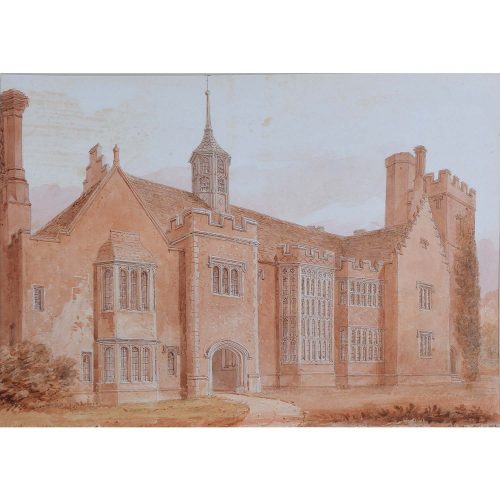
John Chessell Buckler (1793-1894)
Horham Hall Essex 1830
Watercolour 25 x 35.5 cm 44 x 57 cm including frame, UK shipping only J C Buckler was an esteemed architect, coming second to Charles Barry in the competition for the design of the new Houses of Parliament in 1836. However, his greatest passion was recording the details of historical buildings. 'With such subjects before me as cathedrals, abbeys and ancient parish churches...I never made any effort to increase the number of my employments as an architect.' Buckler 1852 Harmoniously working with his father and younger brother, Buckler drew and preserved the designs of ancient structures, many of which no longer survive today. Horham Hall is stands as a fortunate exception. If you are interested email info@manningfineart.co.uk or call us on 07929 749056. Condition: Good. -
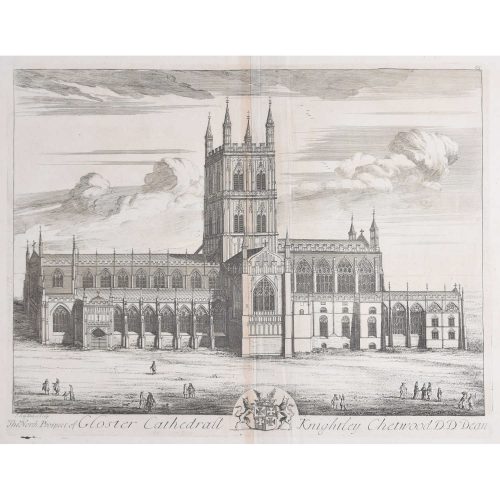
Johannes 'Jan' Kip (1652/3 - 1722)
The North Prospect of Gloster Cathedral (c.1716)
43 x 47 cm Copper engraving Johannes "Jan" Kip was a Dutch engraver, draughtsman and print dealer. After producing works for the court of William of Orange in Amsterdam, Kip followed William and Mary to London, settling in Farringdon and selling prints. Later, Kip collaborated with draughtsman and painter Leonard Knyff, and together they made a popular series of engraved views of English country houses. This print is from Sir Robert Atkyn's 'The Ancient and Present State of Gloucestershire'. In his usual manner - Kip was probably the foremost engraver of his time in England - he has placed figures before the Cathedral to give life - and scale - to the building. Condition: Generally very good with central vertical fold and adjacent parallel creases; one diagonal crease mid left to bottom centre. Will look very good when framed. -
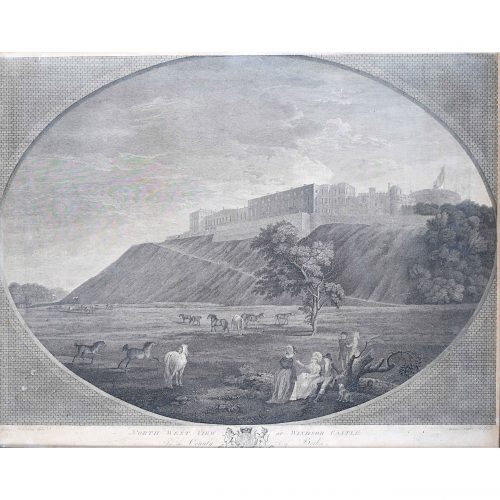
James Fittler (1758-1835) after George Robertson (1748-1788)
North West View of Windsor Castle in the County of Berks (1782)
47x58cm London: Published by John Boydell Fittler engraved two views of Windsor by Robertson. Trained at Royal Academy Schools, he was a skilled engraver and etcher and joined the mid-18th century trend for recording the landscape of the British Isles, producing and selling prints to tourists. A copy of this print is in the National Trust's collection at Anglesea Abbey, from Lord Fairhaven's extraordinary collection of views of Windsor Castle. -
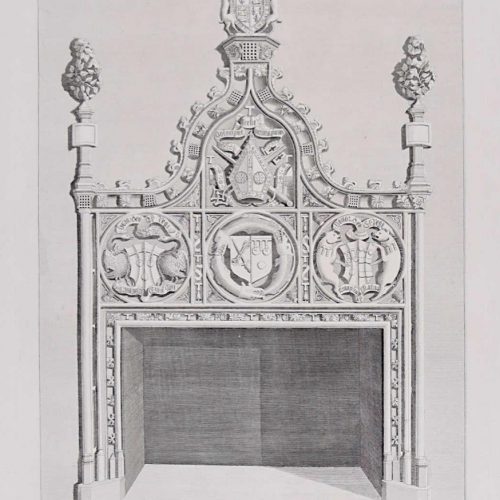
James Basire
James Basire engraving of Bishop's Palace Exeter
Engraving 50 x 33 cm (to plate mark) Published by the Society of Antiquaries 23rd April 1796. A member of the Society of Antiquaries, Basire specialised in architectural prints. He was appointed as engraver to the society, much of his finest works being found in their Vestuta Monumenta. Basire's father Isaac was a cartographer, and both his son and grandson were called James and also worked for the society. William Blake was apprenticed to Basire for seven years. If you are interested, email info@manningfineart.co.ukor call us on 07929 749056. -
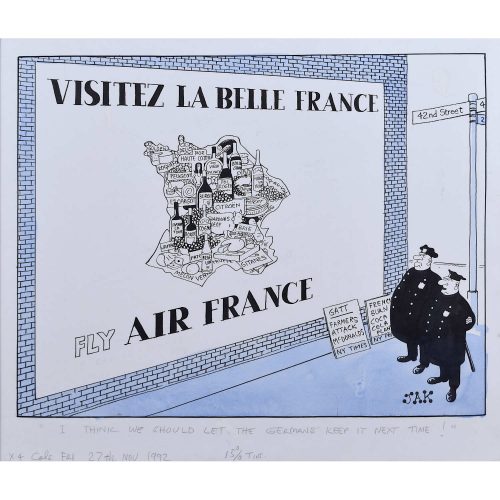
JAK (Raymond Allen Jackson) 1927-1997
"I think we should let the Germans keep it next time" (1992)
Visitez La Belle France, Fly Air France 51x59cm Pen, ink and monochrome wash with inscriptions in pencil. For the London Evening Standard JAK was one of Britian's best-known political cartoonists, working for the London Evening Standard and the Daily Mail between the 1950s and 1990s. He left school at the age of 14, and after a brief career as a messenger boy studied at Willesden College of Technology, studying art with the aim of becoming an art teacher. Following National Service (in the Territorial Army, teaching conscripts to paint), in 1950 he became a staff artist at Link House Publications, and then at advertising agency J Keymer & Co. Whilst working here he submitted cartoons to Punch and other journals, joining the Evening Standard in 1952 as illustrator, also drawing occasional cartoons. In 1966, following the suicide of 'Vicky' (Victor Weisz), he became policital cartoonist at the Evening Standard. Some of his cartoons were highly controversial. In 1970 he caricatured power workers (then striking to improve their conditions) as stupid, greedy and deaf to reason; the entire Evening Standard staff nearly went on strike in response. In 1982 a cartoon in response to the Northern Ireland situation (he frequently depicted Irish people negatively) caused Ken Livingstone to withdraw all advertising from the Standard. His style was distinctive, drawn in ink on 17" x 21.5" board using a mapping pen and brush. His signature was always in a bottom corner, with blob-like serifs, and the title and other instructions were drawn on the picture in pencil. He also drew cartoons for the Mail on Sunday, Daily Express, and Sunday Express. -
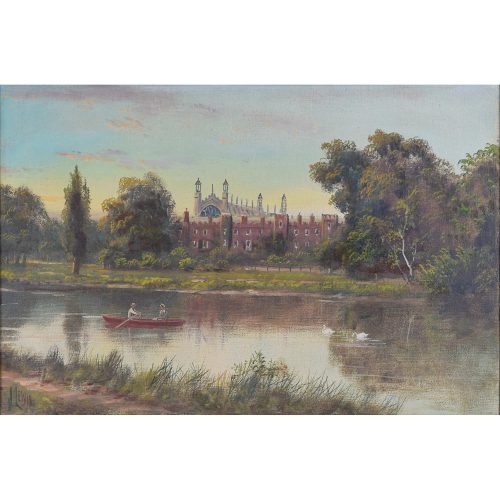
J. Lewis (fl. 1801-1808)
Eton College from the River
Oil on canvas 41 x 62 cm Signed lower left. While not a prolific artist, Lewis was noted for his views of the Thames - this view of Eton College is remarkable for its depiction of the river and wider environs of the school, as well as its architecture. Two snowy swans and boater-clad boys complete the view from the other sides of the Thames. Condition: very good. -
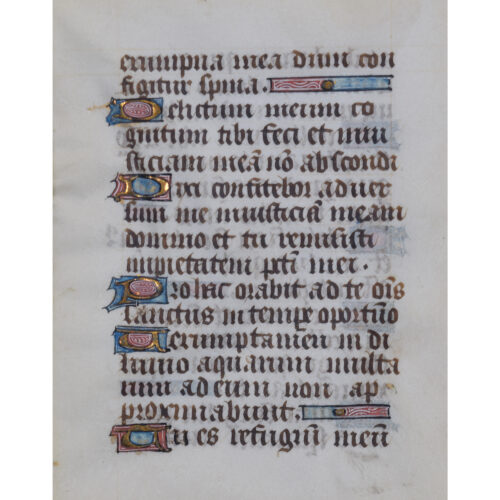
Illuminated psalter - Psalm 31
Illuminated manuscript on vellum 15 x 11 (sheet), 11 x 9 cm (framed area) A beautifully illuminated psalter page, including the Latin text of Psalm 31. Condition: generally very good; some creases to vellum; age toning to margins (not affecting the illuminated area). Will be framed two-sided with age-toned margins not visible. If you are interested, please email info@manningfineart.co.uk or call us on 07929 749056. -

Sir Hugh Casson (1910-1999)
The Chapel at Radley College
Lithographic print signed in pencil. Proof print aside from series. Provenance: the artist’s estate. 28 x 35 cm (11 x 14 in) If you are interested email info@manningfineart.co.uk or call us on 07929 749056. For biographical details and other works by the artist click here. -

Sir Hugh Casson (1910-1999)
The Chapel at Radley College
Lithographic print signed in pencil and numbered 18/250. Provenance: the artist’s estate. 28 x 35 cm (11 x 14 in) If you are interested email info@manningfineart.co.uk or call us on 07929 749056. For biographical details and other works by the artist click here. -
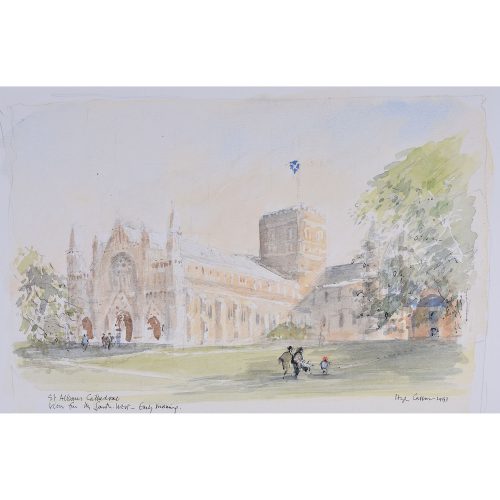
Sir Hugh Casson (1910-1999)
St. Albans Cathedral
Lithographic proof print, out of series. Signed in the plate, not pencil-signed. Provenance: the artist’s estate. 28 x 35 cm (11 x 14 in) If you are interested email info@manningfineart.co.uk or call us on 07929 749056. For biographical details and other works by the artist click here. -
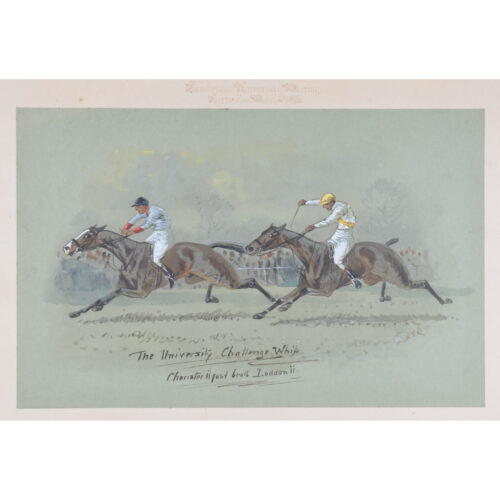
William Verner Longe (1857-1924)
The University Challenge Whip (1900)
Watercolour 29 x 45 cm Signed and inscribed "Choristor ii just beats Loddon ii". Inscribed 'Cambridge University Meeting, Cottenham, March 1909' to mount. A lively racing scene by William Verner Longe, and English artist noted for his scenes of racing, hunting, and other equestrian activities. He was educated at the Ipswich School of Arts and then the Royal Academy of Fine Arts in Antwerp. Condition: generally good; some spots to mount. If you are interested, please email info@manningfineart.co.uk or call us on 07929 749056. Click here for other Cambridge pictures. -
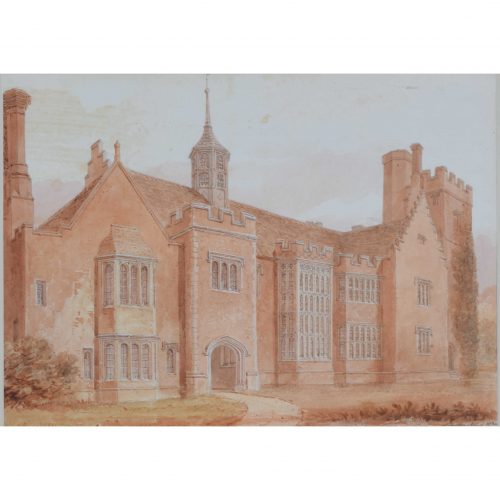
John Chessell Buckler (1793 - 1894)
Horham Hall, Essex (1830)
Watercolour 25 x 34 cm Signed and dated lower right; titled below. Horham Hall was built in Thaxted, Essex by Sir John Cutte in the early sixteenth century. The original hall was a timber-framed moated manor house built circa 1470, but it was largely demolished by Cutte, who built the present house between 1510 and 1515. Cutte was under-treasurer in the households of Henry VII and Henry VIII. The mansion was built in brick in two storeys in a quadrilateral layout with a gatehouse and incorporated some elements of the former building. The house was visited three times by Elizabeth I as the guest of Sir John Cutte. It is believed that the Tower was built for her to watch the local hunt. It was while staying at Horham in 1578 that the Queen received the envoy of the Duke of Alençon proposing marriage. John Chessell Buckler was a British architect, the eldest son of the architect John Buckler. His work included restorations of country houses and at the University of Oxford. Buckler received art lessons from the painter Francis Nicholson. He began working for his father's architectural practice in 1810, and ran it from 1830 onwards with his younger brother George. They worked in partnership until 1842. Buckler did a lot of work in Oxford, carrying out repairs and additions to St. Mary's Church, and Oriel, Brasenose, Magdalen, and Jesus Colleges. He also restored Oxburgh Hall, Norfolk, and Hengrave Hall, Suffolk, and designed Dunston Hall, Norfolk, and Butleigh Court in Somerset. In 1836 he came second, behind Charles Barry, in the competition to rebuild the Palace of Westminster following its destruction by fire. Buckler's writings included the text accompanying his father's engravings of Views of the Cathedral Churches of England and Wales (1822). In 1823 he published 'Observations on the Original Architecture of St. Mary Magdalen College, Oxford', in which he expressed his hostility towards changes in the quadrangle of Magdalen College. Some of his later writings, such as 'A History of the Architecture of the Abbey Church of St Alban' (1847), were written in collaboration with his own son, Charles Alban Buckler. He wrote a further polemical work, 'A Description And Defense Of The Restorations Of The Exterior Of Lincoln Cathedral' (1866), a scathing response to accusations that, in capacity as honorary architect to Lincoln Cathedral, he had overseen a damaging restoration involving the 'scraping' of the cathedral fabric. He died at the grand old age of 100 in 1894. Condition: good. Some spots to the sky, as visible in photograph. If you’d like to know more, please email info@manningfineart.co.uk or call us on 07929 749056. -
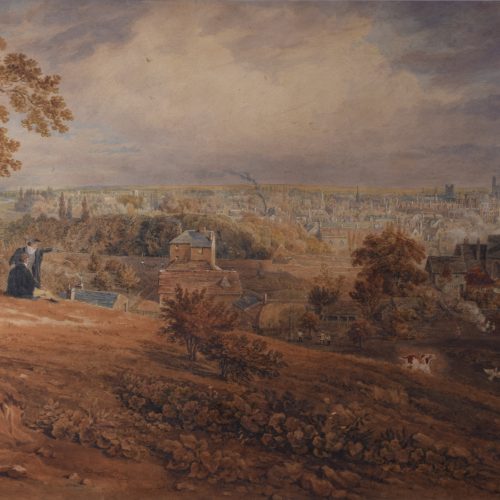
Henry Sargant Storer (1791-1837)
A view of Cambridge from Castle Hill c.1824
Watercolour 46x74.5cm Original watercolour for engraving published in c. 1824. A copy of the engraving is available to view. Provenance: the family of the artist. A very large and very fine view of Cambridge from Castle Hill. New Court of St John's College shines brightly, being in the course of construction - it was finished in 1831. A later panorama of Cambridge in 1838 shows Jesus Green lock in the course of construction. If you are interested email info@manningfineart.co.uk or call us on 07929 749056. -
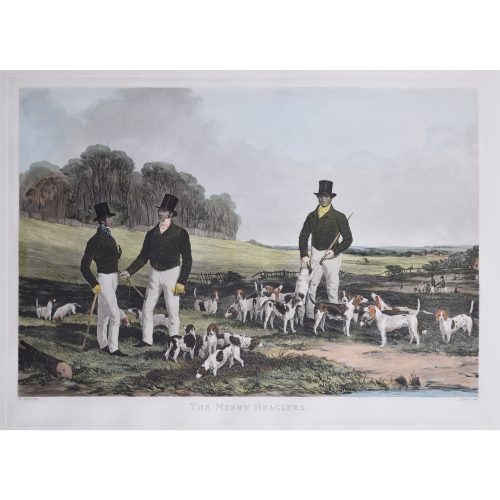
John Harris after Harry Hall The Merry Beaglers
Restrike print - c. mid twentieth century 48x65cm Aquatint with hand colouring The most famous beagling print there is, after the 1845 painting. If you are interested email info@manningfineart.co.uk or call us on 07929 749056. -
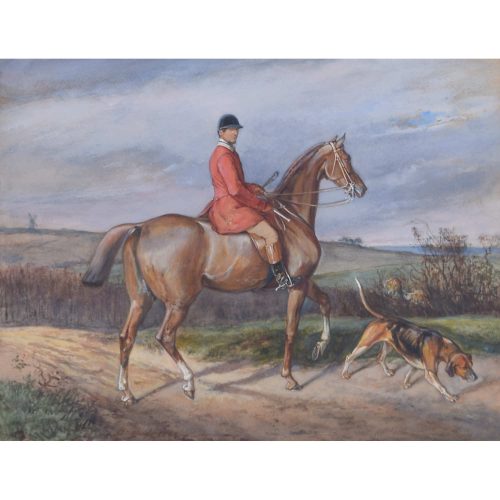
H. Fluiss
Charles Payne, Huntsman to the Pytchley Hounds on Redtape with the hound Trueman (1862)
Watercolour with body colour 36 x 43 cm A mid-nineteenth century watercolour depicting Charles Payne (1884–1967), huntsman to the Pytchley. Condition: very good. If you are interested, please email info@manningfineart.co.uk or call us on 07929 749056. -
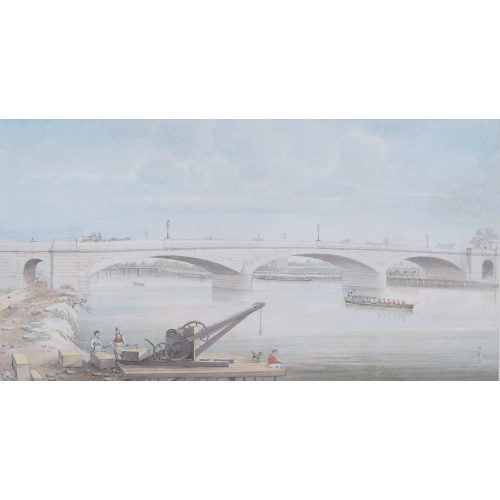
Gideon Yates
View on The Thames with Staines Bridge
25 x 48 cm Watercolour Charmingly signed lower left, on the side of the stone c.1830 Little is known of the life of Yates. Even his date of death is disputed with some sources putting it at 1837. What is known is that he spent most of his working life in London, producing many detailed views of The Thames such as this one. His style is very distinctive, and this large and impressive view of London Bridge is a typical view. He is thought to have lived in Lancaster in 1811, and to have travelled widely throughout Britain and the Continent. His works are in public collections including the Victoria and Albert Museum. UK Government Art Collection item 6701 is another view of The Thames by Yates. Click here for other paintings by Yates. If you are interested email info@manningfineart.co.uk or call us on 07929 749056. -
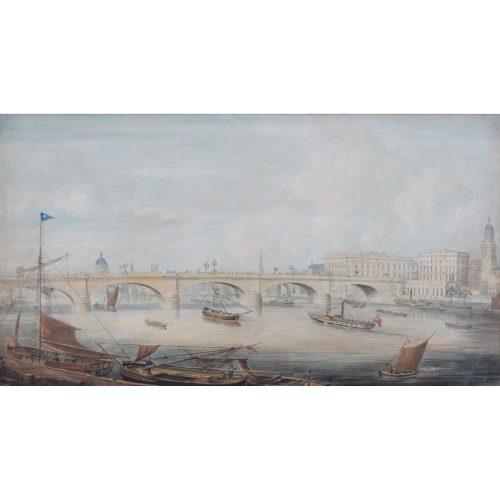
Gideon Yates (?1790-?1840)
1831 View on The Thames with London Bridge from the East Side showing Fishmonger's Hall, The Church of St Magnus the Martyr and St. Paul's Cathedral.
c.1831 29x54cm Watercolour unsigned Provenance: The Parker Gallery LIttle is known of the life of Yates. Even his date of death is disputed with some sources putting it at 1837. What is known is that he spent most of his working life in London, producing many detailed views of The Thames such as this one. His style is very distinctive, and this large and impressive view of London Bridge is a typical view. He is thought to have lived in Lancaster in 1811, and to have travelled widely throughout Britain and the Continent. His works are in public collections including the Victoria and Albert Museum. In this view, Thames barges are in the foreground with their distinctive brown sails. A steamship proceeds along the middle of The Thames. The first steamboat patented was in 1729, by John Allen an English physician. However it was not until 1783 that the first steam-powered ship, "Pyroscaphe," was demonstrated on the River Saône. By 1788 John Fitch in Philadelphia was operating a commercial service along the Delaware River were built in the United States. The first sea-going steamboat was the "Experiment" built by Richard Wright in 1813; by this point river services were becoming well established although it was not until 1815 that The Thames acquired its first successful services with "Margery" and "Thames" arriving from the Clyde where they had been in service for some years. Margate and Gravesend were the main destinations. The steamboat in this view is a paddlesteamer, with two side wheels. At the north end of London Bridge (on the far side from the viewer) is Fishmongers' Hall, St Magnus the Martyr Church is visible on the near side of the bridge, and St Paul's Cathedral is visible beyond. UK Government Art Collection item 6701 is another view of The Thames by Yates, also from The Parker Gallery. If you are interested email info@manningfineart.co.uk or call us on 07929 749056. -
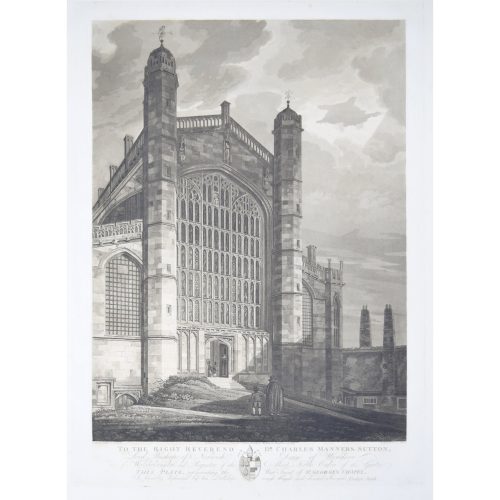
Frederick Nash (1782-1856) Drawn and etched Engraved by F C Lewis West Front of St George's Chapel, Windsor
To the Right Reverend the Lord Bishop of Norwich and Dean of Windsor London Published by F Nash, No 6 Asylum Buildings, Westminster Road July 12 1804 55x40cm Frederick Nash was born in Lambeth. Initially studying architectural drawing under Thomas Malton he subsequently enrolled at the Royal Academy of Arts. From 1801 to 1809 he worked with the antiquarians John Britton and Edward Wedlake Brayley, subsequently becoming a member of the Society of Painters in Watercolours - a group of painters who had left the Royal Academy following complaints of under-recognition of their works. Latterly primarily a landscape painter he toured the rivers of Germany. Prints from this series are in the British Museum and also in the collection of Anglesea Abbey, a National Trust property outside Cambridge, England, with a very large collection of views of Windsor Castle. If you are interested email info@manningfineart.co.uk or call us on 07929 749056. Condition: A good impression In generally very good condition. Not trimmed. -
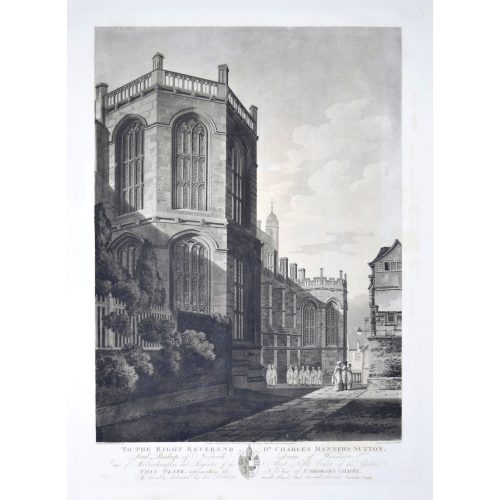
Frederick Nash (1782-1856) Drawn and etched Engraved by F C Lewis North East View of St George's Chapel, Windsor
To the Right Reverend the Lord Bishop of Norwich and Dean of Windsor London Published by F Nash, No 6 Asylum Buildings, Westminster Road July 12 1804 55x40cm Frederick Nash was born in Lambeth. Initially studying architectural drawing under Thomas Malton he subsequently enrolled at the Royal Academy of Arts. From 1801 to 1809 he worked with the antiquarians John Britton and Edward Wedlake Brayley, subsequently becoming a member of the Society of Painters in Watercolours - a group of painters who had left the Royal Academy following complaints of under-recognition of their works. Latterly primarily a landscape painter he toured the rivers of Germany. Prints from this series are in the British Museum and also in the collection of Anglesea Abbey, a National Trust property outside Cambridge, England, with a very large collection of views of Windsor Castle. If you are interested email info@manningfineart.co.uk or call us on 07929 749056. Condition: A good impression In generally very good condition. Not trimmed. -
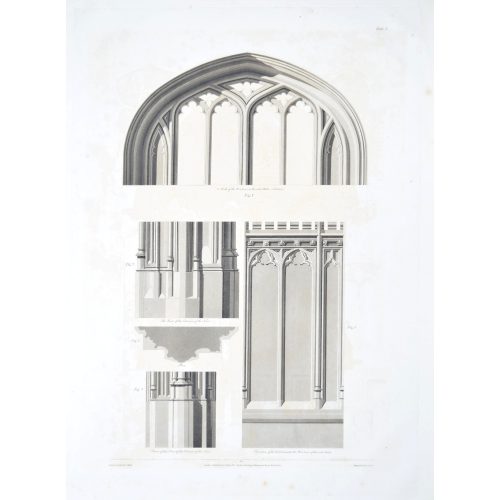
Frederick Nash (1782-1856) Drawn and etched Engraved by F C Lewis Arches and Columns
London Published by F Nash, No 6 Asylum Buildings, Westminster Road July 12 1804 55x39cm Frederick Nash was born in Lambeth. Initially studying architectural drawing under Thomas Malton he subsequently enrolled at the Royal Academy of Arts. From 1801 to 1809 he worked with the antiquarians John Britton and Edward Wedlake Brayley, subsequently becoming a member of the Society of Painters in Watercolours - a group of painters who had left the Royal Academy following complaints of under-recognition of their works. Latterly primarily a landscape painter he toured the rivers of Germany. If you are interested email info@manningfineart.co.uk or call us on 07929 749056. Condition: In generally good condition, some offsetting of ink from adjacent print as visible in image, occasional spotting. Not trimmed. -
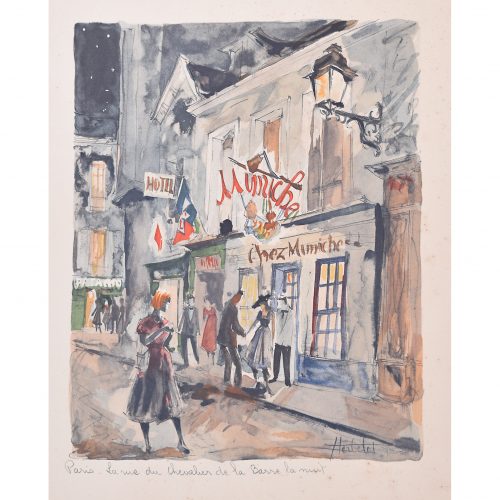 Franz Herbelot (French, active 1940s-1950s) Paris: La Rue de Chevalier de la Barre la nuit Lithograph 28 x 22 cm A fantastic lithograph by Herbelot which brilliantly captures the spirit of mid-century Paris. Little is known of Herbelot's life, but he is most notable for his views of Paris. The Rue de Chevalier de la Barre is a street in Montmartre named after the Knight de la Barre, François-Jean Lefebvre de la Barre, who died in 1766. Here, we see the street as it was in the 20th century, brimming with ladies and gentlemen dressed à la mode, bathed in the warm light of thriving bistros and hotels.
Franz Herbelot (French, active 1940s-1950s) Paris: La Rue de Chevalier de la Barre la nuit Lithograph 28 x 22 cm A fantastic lithograph by Herbelot which brilliantly captures the spirit of mid-century Paris. Little is known of Herbelot's life, but he is most notable for his views of Paris. The Rue de Chevalier de la Barre is a street in Montmartre named after the Knight de la Barre, François-Jean Lefebvre de la Barre, who died in 1766. Here, we see the street as it was in the 20th century, brimming with ladies and gentlemen dressed à la mode, bathed in the warm light of thriving bistros and hotels. -
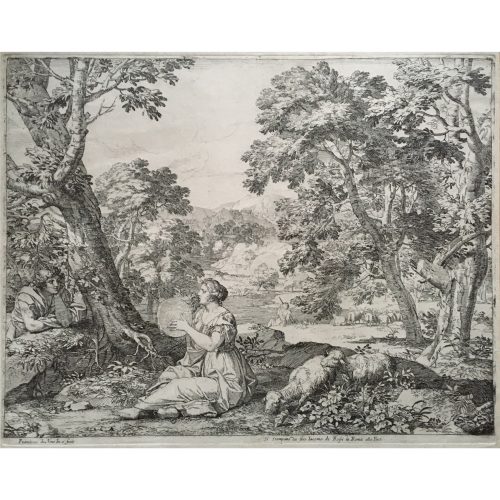
Franciscus de Neve (c.1632-1704) 'Landscape with Shepherdess Playing a Tambourine' and 'Echo & Narcissus'
Engravings Both signed in the lower margin: 'Franciscus de Neue In. e fecit' and 'Si Stampano in Roma da Gio: Iacomo de Rossi alla Paca' Each 31.5 x 38.5cm (plate) Franciscus (or Frans) de Neve was a Flemish painter and engraver, born in Antwerp in 1632. His father, also an artist, was called by the same name, resulting in some confusion for art historians. The younger de Neve was working in Rome from 1660-1670, producing paintings for the Palazzo Doria-Pamphili (alongside Pietro da Cortona) and was known for his religious subjects, mythological scenes and landscapes. He was part of a network of Dutch and Flemish artists in the city, who helped to promote and support his career. Many of his works are known only from the engravings which in Rome were produced by Giovanni Giacomo de Rossi alla Pace (including these examples). After 1670 he travelled to Augsburg and Munich, then to Austria and Moravia, where he completed numerous commissions for altarpieces. Towards the end of his life he returned to his native Flanders and became Master of the Guild of Saint Luke. De Neve had a reputation as a gifted landscape painter, and these two engravings show his keen interest in the details of the natural world, as well as the influence of Claude Lorrain in the extensive vistas. The painting of ‘Narcissus and Echo’ after which this engraving was made, hangs in the collection of Christ Church College, Oxford - one of his few original oils known to survive. Another of the prints is owned by the British Museum. If you are interested email info@manningfineart.co.uk or call us on 07929 749056. Condition: Good. -
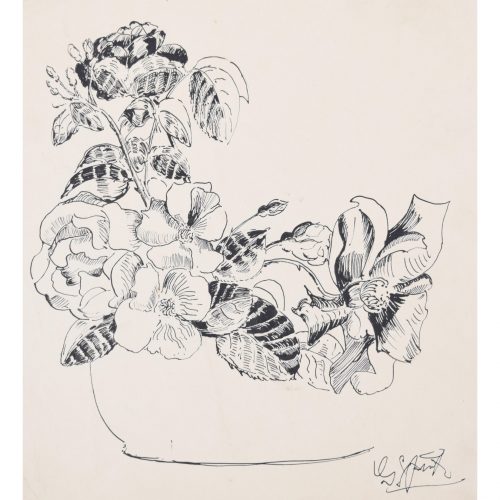
Gerald Mac Spink (flourished 1920 - 1940)
Flowers
Pen and ink 15 x 23 cm Signed 'G Spink' lower right. Spink was a skilled artist, illustrator, and designer who produced a series of posters in the inter-war period for companies including the London Underground, Southern Railways, LNER, Hawker Engineering, and British Steel. He won a prize in 1933 from the Imperial Institute for his poster artwork. He also worked as an aeronautical engineer in Kingston-on-Thames for Hawker Engineering; his greatest achievement was the creation of the 'Squanderbug', a 500cc racing car which he built in 1947, and which races even to this day. Provenance: the artist's estate. Condition: generally very good. If you are interested, please email info@manningfineart.co.uk or call us on 07929 749056. Click here for other works by the artist. -
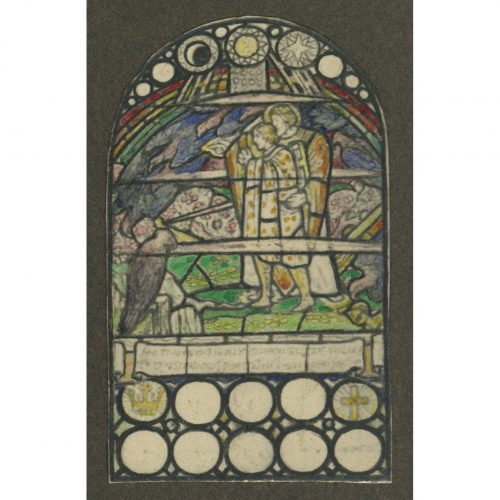
Florence Camm (1874-1960)
Valley of the Shadow of Death Stained Glass Window Design for Wrekin College (1936)
Watercolour 9x6cm Design for TW Camm & Co., Smethwick, Birmingham. If you are interested email info@manningfineart.co.uk or call us on 07929 749056. -
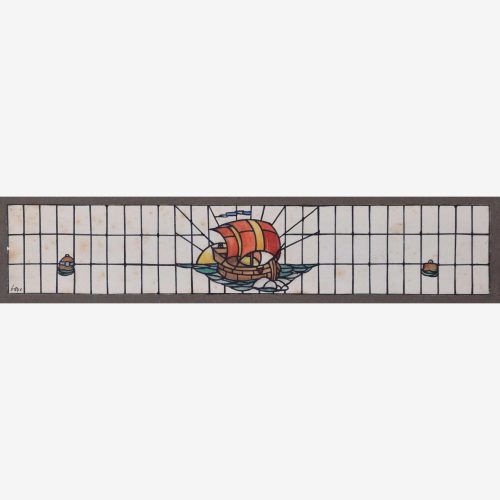
Florence Camm (1874-1960)
Stained Glass Window Design with Red Sailing Ship
Watercolour 6.5x34cm Condition: Some spotting to image; mounted to board - see image. Click for biographical details and other works by Camm. If you are interested email info@manningfineart.co.uk or call us on 07929 749056. -
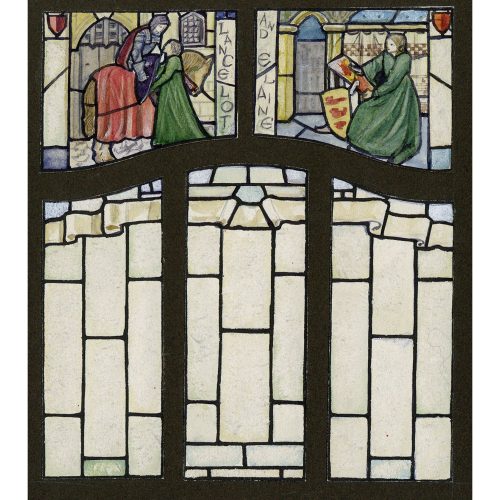
Florence Camm (1874-1960)
Lancelot and Elaine Stained Glass Window Design
Watercolour 13.5x11.5cm Design for TW Camm & Co., Smethwick, Birmingham. If you are interested email info@manningfineart.co.uk or call us on 07929 749056. -
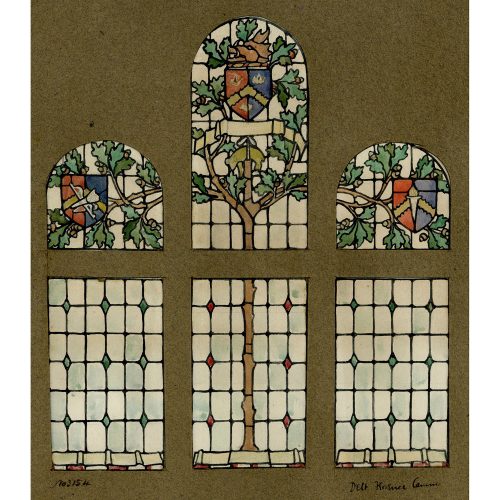
Florence Camm (1874-1960)
Heraldic Stained Glass Window Design with Oak Leaves
Watercolour 20x18cm Click for biographical details and other works by Camm. If you are interested email info@manningfineart.co.uk or call us on 07929 749056. -
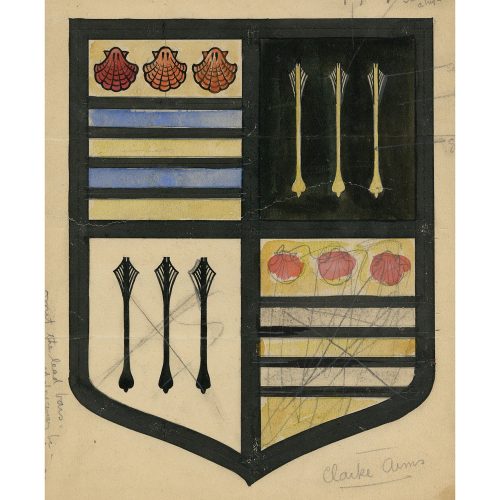
Florence Camm (1874-1960)
Clarke Arms Design
Watercolour and pencil 22x17cm Design for TW Camm & Co. If you are interested email info@manningfineart.co.uk or call us on 07929 749056. -
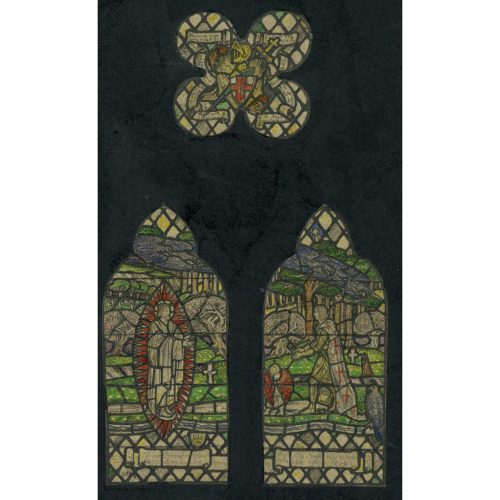
Florence Camm (1874-1960)
Arthurian Stained Glass Window Design II
Watercolour 16x9.5cm Design for TW Camm & Co., Smethwick, Birmingham. If you are interested email info@manningfineart.co.uk or call us on 07929 749056. -
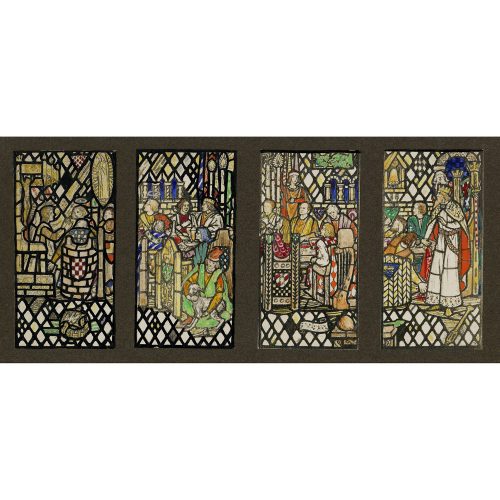
Florence & Walter Camm
Design for Series of Four Arthurian Stained Glass Windows for Mercersburg Academy Chapel, Pennsylvania
1928 Watercolour over photographic background 10 x 24cm Provenance: The archives of TW Camm The Irvine Chapel of Mercersburg Academy was built as a war memorial for the First World War dead of the school. The dead were honoured in a series of stained glass windows that were commissioned from a series of the greatest stained glass designers of the time. If you are interested email info@manningfineart.co.uk or call us on 07929 749056. -
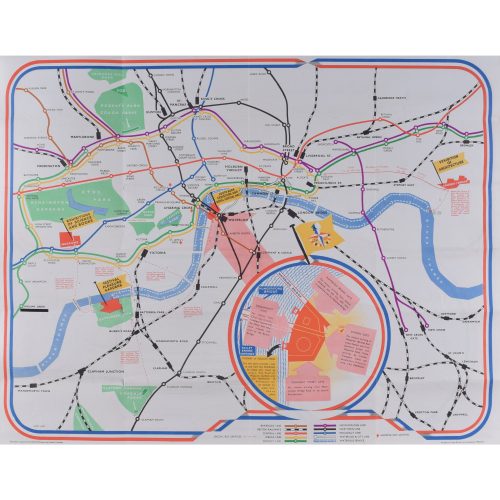
James Hart
Festival of Britain
Lithographic poster map 45 x 58 cm Folding map published for London Transport and British Railways for visitors to the 1951 Festival of Britain, featuring the Abram Games logo, details of water bus services, a detailed plan of the Lambeth exhibition area by Waterloo Bridge. If you are interested email info@manningfineart.co.uk or call us on 07929 749056. -
 Frank Algernon Stewart (1877-1945) The Heythrop at Stow on the Wold Lithograph 24 x 63cm Signed in pencil. Framed. A typical hunting print by Stewart, showing one of the country's leading packs. Condition: Slight, even, loss of colour, as expected. If you’d like to know more, please email info@manningfineart.co.uk or call us on 07929 749056.
Frank Algernon Stewart (1877-1945) The Heythrop at Stow on the Wold Lithograph 24 x 63cm Signed in pencil. Framed. A typical hunting print by Stewart, showing one of the country's leading packs. Condition: Slight, even, loss of colour, as expected. If you’d like to know more, please email info@manningfineart.co.uk or call us on 07929 749056. -
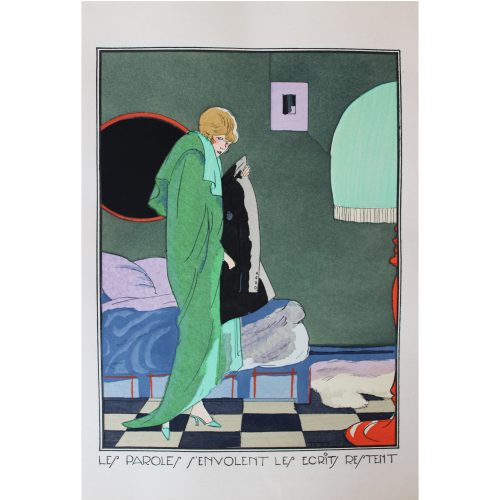
After Ettore Tito (1859-1941) c.1920s A set of four pochoir prints: 'Les paroles s'envolent les ecrits restent'; 'On a souvent besoin d'un plus petit que soi'; 'Qui trop embrasse...'; 'Aide-toi le ciel t'aidera'
23.5 x 16.5 cm (to mount) Ettore Tito (1859-1941) Tito trained at the Accademia di Belle Arti in Venice and later became a professor there, known for his landscapes and scenes of traditional life in the Veneto region, as well as producing several larger mythological murals notably for the Villa Berlinghieri in Rome and the Chiesa degli Scalzi in Venice. He associated with an expatriate artistic milieu that included John Singer Sargent and Isabella Stewart Gardner. However, in the 1920s he also produced these pochoir prints of emancipated women for a French magazine which were considered rather risqué at the time! If you are interested email info@manningfineart.co.ukor call us on 07929 749056. Condition: Excellent, mounted. -
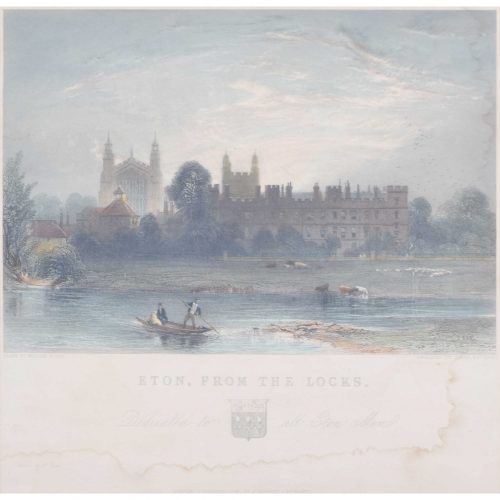
James Redaway (1797 - 1858)
Eton from the Locks
Hand-coloured engraving 27 x 28 cm Redaway's view of Eton College, seen from the locks on the River Thames. James Redaway was a nineteenth-century engraver, principally of landscapes and architectural subjects. Condition: some staining to lower half of print. If you’d like to know more, please email info@manningfineart.co.uk or call us on 07929 749056. -
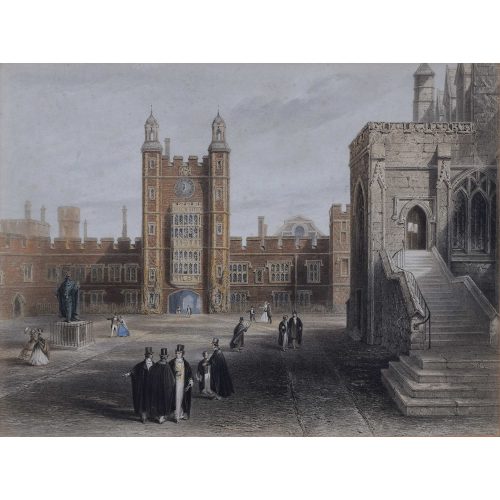
Anonymous (19th century) Eton College Courtyard
Lithograph 29 x 38 cm We have a pair of these rather fine 19th century lithographs: see the second one here. Mounted to board. -
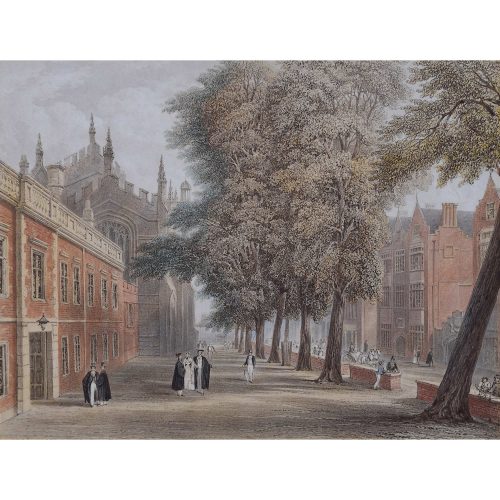
Anonymous (19th century) Eton College
Lithograph 29 x 38 cm We have a pair of these rather fine 19th century lithographs; view the other picture here. Condition: Mounted to board. -
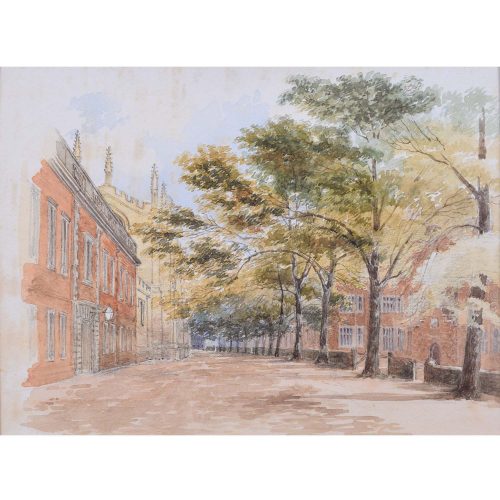
Anonymous Eton College
Watercolour 21.2×28.5cm If you are interested email info@manningfineart.co.ukor call us on 07929 749056. Condition: Good. -
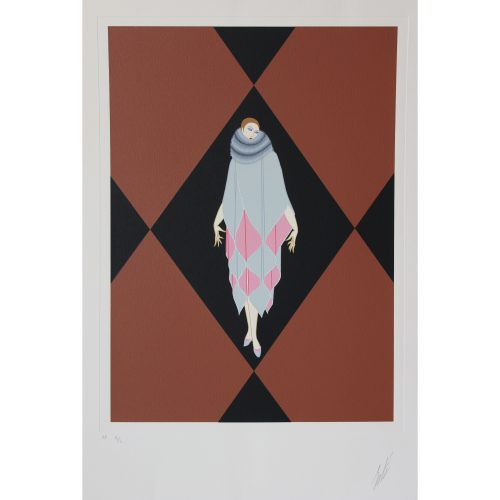
Erté (Romain de Tirtoff) (1892-1990) 'Manhattan Mary IV'
Serigraph (Artist's Proof IL/L) Signed in pencil 70 x 56cm (sheet) 41.5 x 30.5cm (plate) The Russian born Romain de Tirtoff moved to Paris around 1912 to work as a designer, choosing the pseudonym ‘Erté’ based on the French pronunciation of his initials. He produced fashion plates for the designer Paul Poiret and signed a contract with Harper’s Bazaar that saw him design over 200 covers for the magazine. Costume and stage design followed in the 1920s, for the Folies Bergeres and similar revues in Paris, then in Hollywood for Louis B. Mayer. Erté’s distinctive and elegant style came to epitomise the Art Deco era; it is characterised by a combination of sharp geometric line - like the harlequin background to this print - strong colour planes and images of fashionable modern women with close-cropped hair and asymmetric hemlines. Art Deco enjoyed a revival in the 1960s, and it was from this point that limited edition prints began to be produced from Erté’s designs. ‘Manhattan Mary’ was a Broadway musical which opened at the Apollo Theatre, New York in September 1927, with set and costume designs by Erté. If you are interested email info@manningfineart.co.uk or call us on 07929 749056. Condition: Excellent. -
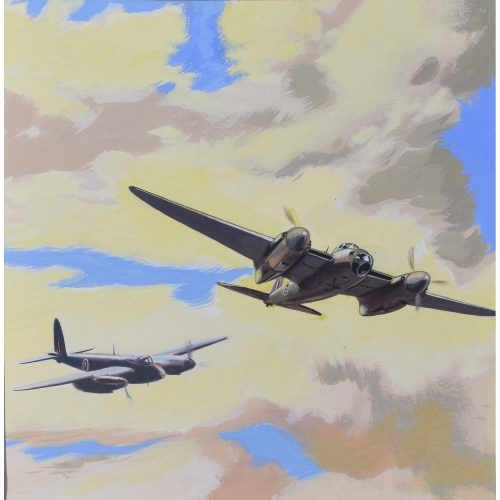
Ernest Bendell-Bayly Mosquito Fighter Bomber
Oil on paper laid on board Design for poster 32x31cm 1940s Ernest Bendell-Bayly was a partner in the Bayly-Souster advertising agency, employer of, amongst others, Owen Miller. If you are interested email info@manningfineart.co.uk or call us on 07929 749056. -
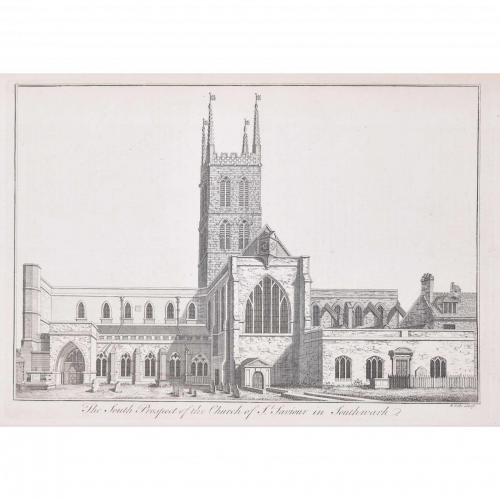
Benjamin Cole (1697-1783)
Southwark Cathedral (c. 1753)
Engraving 24 x 33 cm Stow's Survey of London, a ward-by-ward topographical and historical tour of the City of London giving an account of buildings, social conditions and customs, was first published in 1598. This view of Southwark Cathedral, labelled here as 'the South Prospect of the Church of St Saviour in Southwark', offers a charming perspective of the building's architecture and churchyard. Condition: Generally very good; slight offsetting from facing page and old library stamp to reverse. -
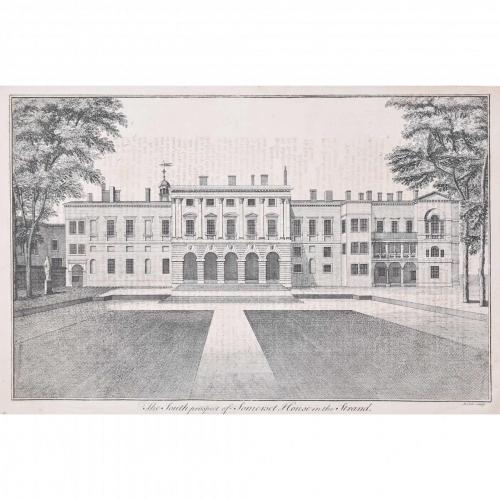
Benjamin Cole (1697-1783)
South Prospect of Somerset House (c. 1753)
Engraving 24 x 37 cm Stow's Survey of London, a ward-by-ward topographical and historical tour of the City of London giving an account of buildings, social conditions and customs, was first published in 1598. Cole's architectural view of Somerset House illustrates the clean neoclassical proportions for which it is known. Condition: Trimmed by the binder's knife within plate marks; some offsetting from facing page; occasional soft creases; generally good. -
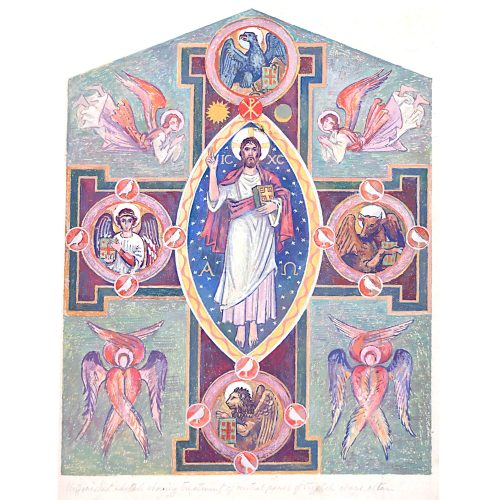
Anonymous Design for Triptych Above Alta
British, c. 1920s Gouache 38x28.5cm Christ Pantocrator stands in the middle of the design, surrounded by the four evangelists - represented by the Eagle, Bull, Lion and Angel - together with two seraphim. This is a well executed design for an as-yet unidentified location. At the bottom is a pencil description as an 'unfinished sketch'. Condition: Generally very good condition. If you are interested email info@manningfineart.co.uk or call us on 07929 749056. -
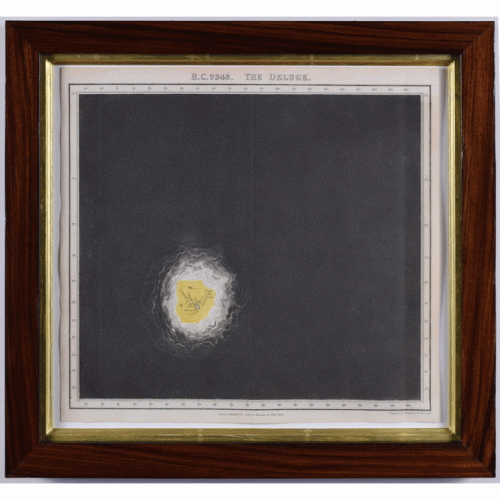
Edward Quin (British 1794-1828)
Twenty-one maps from An Historical Atlas in a Series of Maps of the World As Known at Different Periods.
Twenty-one hand-coloured engraved maps, various sizes, presented in fine hand-finished rosewood veneer frames. Click on the image to see all twenty-one maps. 15 approx 40 x 31 cm 5 approx 62 x 31 cm Seeley and Burnside np. nd. [London c. 1830] Scroll down for further information. -
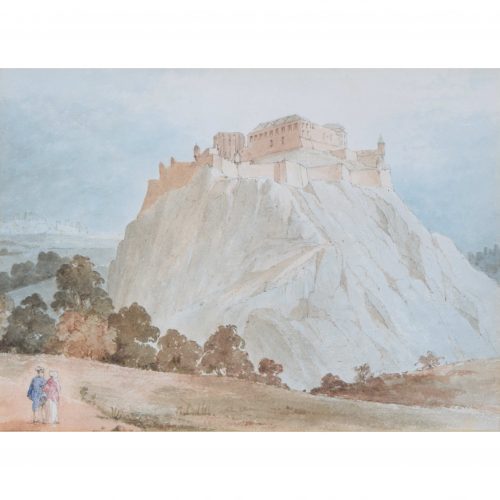
Richard Westmacott (1775 - 1856)
Edinburgh Castle (1800)
Watercolour 29 x 41 cm A watercolour depicting Edinburgh Castle. A Georgian couple gaze up at the immensity of Castle Rock, and the 11th-century fortress perched upon it. Richard Westmacott was British artist who primarily worked as a sculptor. Westmacott studied with his father, also named Richard Westmacott, at his studio in Mount Street, off Grosvenor Square in London, before going to Rome in 1793 to study under Antonio Canova. Upon his return to London in 1797, he established his own studio. He exhibited at the Royal Academy between 1797 and 1839 and was elected an associate of the Royal Academy in 1805, and a full academician in 1811. Condition: very good; handsomely framed. If you’d like to know more, please email info@manningfineart.co.uk or call us on 07929 749056. -
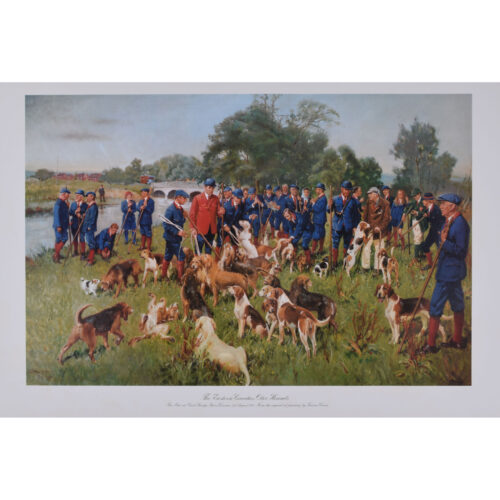
Terrence Cuneo (1907 - 1996)
Eastern Counties Otter Hounds (1971)
Lithograph 56 x 80 cm The meet at Guist Bridge, River Wensum, 31 August 1970. Terence Tenison Cuneo CVO OBE RGI FGRA trained at the Slade School of Art. He worked for the War Artists' Advisory Committee during the Second World War and also produced anti-Nazi propaganda. He most known for his postwar pictures of railways, locomotives, and industry. He was the official artist for the Coronation of Queen Elizabeth II in 1953. Condition: very good. Unsigned proof copy. If you are interested, please email info@manningfineart.co.uk or call us on 07929 749056. Click here for other hunting pictures. -
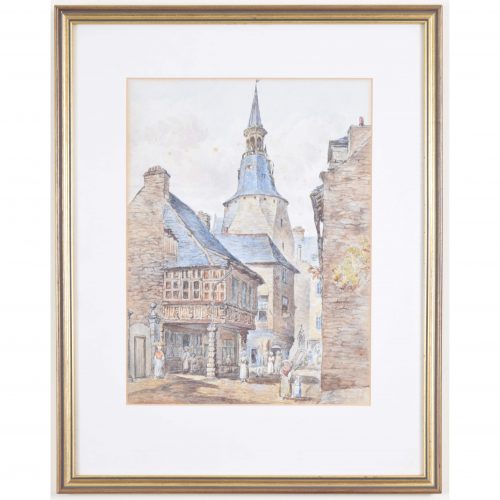
Attributed to Antony Vandyke Copley Fielding (1787 - 1855)
Dinan Tour de l’Horloge (Dinan Clock Tower)
Watercolour 28 x 21 cm A spirited watercolour of Dinan, Brittany. Dinan's famous clock tower looks over a French street scene: men, women, and children weave through the town's half-timbered houses, shops, and ateliers. The characterful mediaeval stonework and architecture of the town are paramount, and the artist adds a bright blue hue to his depiction of Dinan's roofs. Dinan is a walled medieval Breton town and commune in the Côtes-d'Armor department of northwestern France. Enclosed by nearly three kilometres of ramparts, the town and its 14th-century castle proudly overlook the Rance river. Anthony Vandyke Copley Fielding, commonly called Copley Fielding, was an English painter famous for his watercolour landscapes. At an early age Fielding became a pupil of John Varley. In 1810 he became an associate exhibitor in the Old Watercolour Society (later known as the Royal Society of Watercolours), in 1813 a full member, and in 1831 the Society's President. In 1824 he won a gold medal at the Paris Salon, alongside Richard Parkes Bonington and John Constable. Examples of his work are held by the Victoria and Albert Museum and other major museums in Britain. Condition: good. Some spotting to sky; handsomely framed. If you’d like to know more, please email info@manningfineart.co.uk or call us on 07929 749056. -

Student of the National Art Training School (now Royal College of Art)
Decorative Vase
Gouache 40 x 26 cm Stamped 'ESK' ('Examined South Kensington) to reverse. This gouache study of a vase was made by a Royal College of Art (then known as the National Art Training School) student for their examinations. Condition: generally very good; a little discolouration to paper. In attractive frame made from period moulding. If you are interested, please email info@manningfineart.co.uk or call us on 07929 749056. -
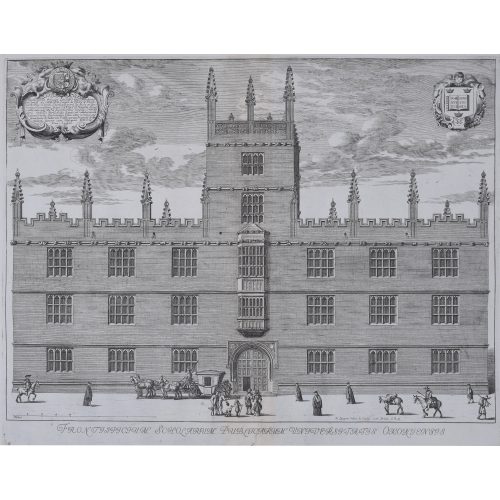
David Loggan (1634-1692)
Frontispiece Public Schools Oxford
Engraving 33x42cm If you are interested email info@manningfineart.co.uk or call us on 07929 749056. -
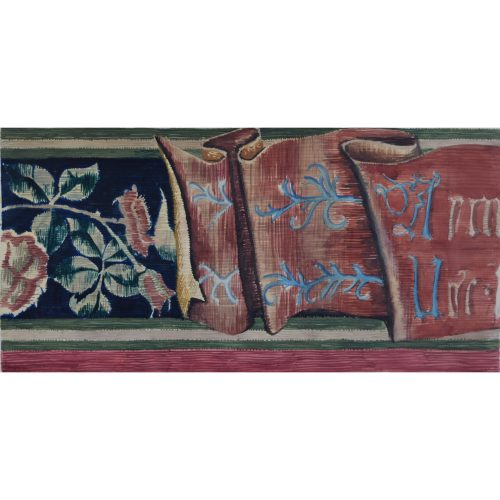
D. L. Hadden
Design for tapestry
Watercolour 25x50cm If you are interested email info@manningfineart.co.uk or call us on 07929 749056. -
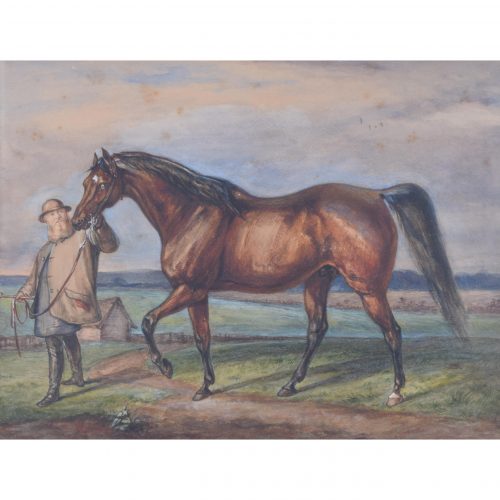
H. Fluiss
Cotherstone with stud groom "Wilson" (1862)
Watercolour 30 x 39 cm A late-nineteenth century watercolour depicting Cotherstone, the British Thoroughbred racehorse and sire. In a career that lasted from September 1841 to July 1843, he ran eleven times and won eight races. Provenance: Christie's South Kensington (2002). Condition: generally very good; couple of faint spots to sky. Frame in "country house" condition. If you are interested, please email info@manningfineart.co.uk or call us on 07929 749056. -
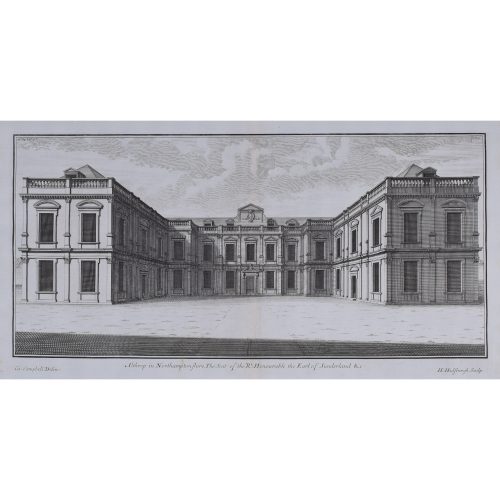
Colen Campbell (1676-1729)
Althrop Hall in Northamptonshire the Seat of the Rt Honourable The Earl of Sunderland & co.
35x50cm Engraving (1715-1725) from 'Vitruvius Britannicus, or the British Architect...' Althorp Hall - as it is now written, but still pronounced 'Althrop' - is the seat of the Earl Spencer and the location of the grave of Diana, Princess of Wales. Colen Campbell was a Scottish architect and architectural writer, renowned for being a founder of the Georgian style. His major published work was 'Vitruvius Britannicus' which was a catalogue of design, containing a series of engravings of English buildings by Inigo Jones, Sir Christopher Wren, Campbell himself and other prominent architects of the era. It was published in three volumes between 1715 and 1725.

